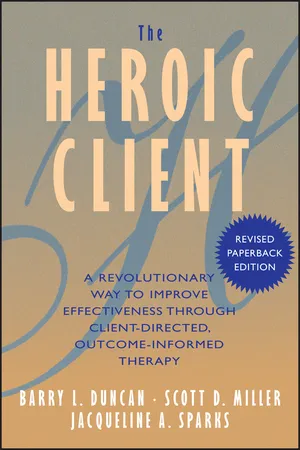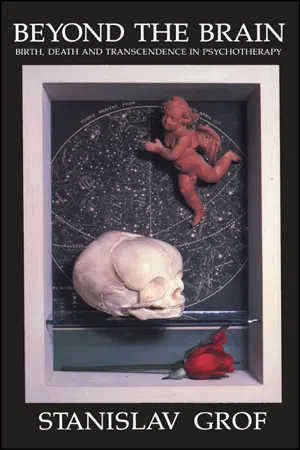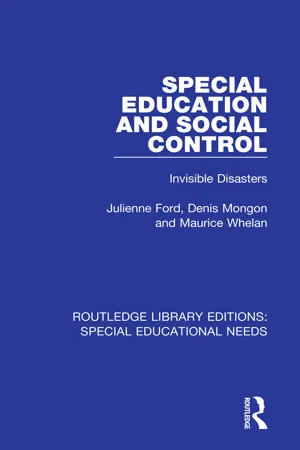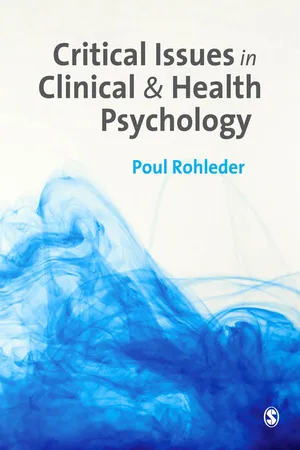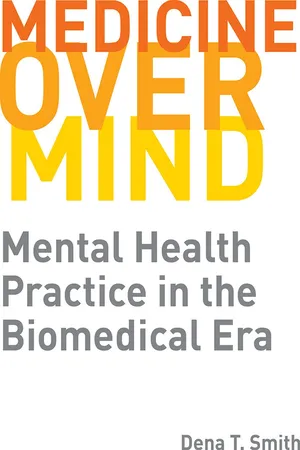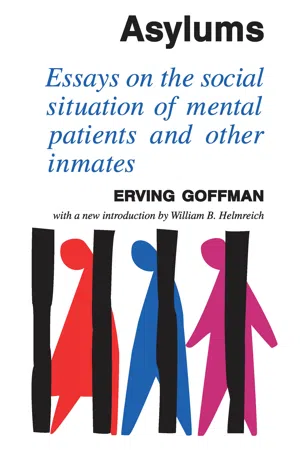Psychology
Medical Model
The medical model in psychology refers to the approach of understanding mental health issues as medical conditions that can be diagnosed and treated. It emphasizes the role of biological and genetic factors in mental disorders and often involves the use of medication and other medical interventions. This model is based on the idea that mental illnesses are similar to physical illnesses and should be treated as such.
Written by Perlego with AI-assistance
Related key terms
10 Key excerpts on "Medical Model"
- eBook - ePub
The Heroic Client
A Revolutionary Way to Improve Effectiveness Through Client-Directed, Outcome-Informed Therapy
- Barry L. Duncan, Scott D. Miller, Jacqueline A. Sparks(Authors)
- 2011(Publication Date)
- Jossey-Bass(Publisher)
CHAPTER TWOThe Myth of the Medical ModelDethroning Diagnosis and Best PracticeThe great tragedy of science—the slaying of a beautiful hypothesis by an ugly fact.—Thomas Henry Huxley, Presidential Address to the British Association for the Advancement of ScienceThe Medical Model, emphasizing diagnostic classification and evidence-based practice, has been transplanted wholesale into the field of human problems. Psychotherapy is almost exclusively described, researched, taught, practiced, and regulated in terms of the Medical Model’s assumptions and practices. But how did we get here?Psychologist George Albee (2000) suggests that psychology made a Faustian deal with the Medical Model over fifty years ago when it uncritically accepted the call to provide psychiatric services to returning veterans of World War II. The Medical Model was perhaps permanently stamped, however, at the famed Boulder conference in 1949, where psychology’s bible of training was developed, under protest by many, with an acceptance of medical language and the concept of “mental disease.”Later, with the passing of freedom of choice legislation guaranteeing parity with psychiatrists, psychologists learned to treat clients in private offices and collect from third-party payers requiring only a psychiatric diagnosis for reimbursement. The other mental health professions soon followed suit—all vying to get a slice of the pie, not thinking about the long-term consequences of a high-fat, highcarbohydrate diet. Soon thereafter, in the mid-1980s, the rising tide of the Medical Model reached dangerous levels of influence. Drowning any possibilities for other ways of understanding human challenges, the National Institute of Mental Health (NIMH), the leading source of research funding for psychotherapy, decided to apply the same methodology used in drug research to evaluate psychotherapy—the randomized clinical trial (RCT).Adopting the RCT for evaluating psychotherapy had profound ramifications. It meant that a study must include manualized therapies (to approximate drug protocols) and DSM - eBook - ePub
Beyond the Brain
Birth, Death, and Transcendence in Psychotherapy
- Stanislav Grof(Author)
- 1985(Publication Date)
- SUNY Press(Publisher)
1 Individuals who suffer from such disorders receive socially stigmatizing labels and are routinely called “patients.” They are treated in medical facilities where the per diem expenses for hospitalization amount to several hundred dollars. Much of this cost reflects enormous overhead directly related to the Medical Model, such as costs for examinations and services that are of questionable value in the effective treatment of the disorder in question. Much research money is dedicated to refining medically oriented research that will eventually discover the etiology of “mental diseases” and thus confirm the medical nature of psychiatry.There has been increasing dissatisfaction with the application of the Medical Model in psychiatry. Probably the best known and most eloquent representative of this movement is Thomas Szasz. In a series of books, including his Myth of Mental Illness (1961), Szasz has adduced strong evidence that most cases of so-called mental illness should be regarded as expressions and reflections of the individual’s struggles with the problems of living. They represent social, ethical, and legal problems, rather than “diseases” in the medical sense. The doctor-patient relationship as defined by the Medical Model also reinforces the passive and dependent role of the client. It implies that the solution of the problem depends critically on the resources of the person in the role of scientific authority, rather than on the inner resources of the client.The consequences of the Medical Model for the theory and practice of psychiatry are far reaching. As a result of the mechanical application of medical thinking, all disorders that a psychiatrist deals with are seen in principle as diseases for which the etiology will eventually be found in the form of an anatomical, physiological, or biochemical abnormality. That such causes have not yet been discovered is not seen as a reason to exclude the problem from the context of the Medical Model. Instead, it serves as an incentive for more determined and refined research along medical lines. - eBook - ePub
Special Education and Social Control
Invisible Disasters
- Julienne Ford, Denis Mongon, Maurice Whelan(Authors)
- 2018(Publication Date)
- Routledge(Publisher)
The model has outgrown and now outlived its original value; but instead of leaving a residue, concentrated in the particular cases where it would still be useful, it instead maintains a profound influence over the whole question. It is fair to say that in the nineteenth century the model enabled workers and the public to place mental health in a framework they could understand: sickness and treatment. This ushered in a more humanitarian approach, and replaced the previous diabolism and penology with amelioration and remediation. Even now the model may have some value in individual cases where either the aetiology is idiosyncratic or where we need to understand why one individual rather than another has succumbed to the social pressures to which we refer. A sense of individualistic sympathy should be a part of all our professional and personal sense. Where the Medical Model not only fails but even hinders is in the extent to which it is not just a part but rather the cornerstone of the education services, approach. It is so because it serves a variety of purposes, not all of which would be acknowledged as the principal concerns of many of the professionals involved.The status of medicine and the Medical Model for treatment of mental health issues is such that labels drawn from that model are remarkable ‘depoliticisers’ of the issues, so that ‘non-conformity and deviance are often explained as being symptoms of maladjustment’ (Morton, 1971). Once we locate the source and the treatment of problems in an individual, other levels of analysis and intervention are effectively closed. By the very acceptance of a specific behaviour as a treatable syndrome, a kind of illness, and the definition of illness as an undesirable state, the issue becomes not whether to deal with that particular problem but only how and when. The issues about what freedom and licence individuals should have are shunted to one side in a debate over the degree of sickness and risk to social health attached to the phenomenon in question (Zola, 1972).We have moved from what Michael Roe calls the ‘strong form’ of the Medical Model (the direct analogy between physical and psychogenic illness, the anatomy of the psyche) into what he calls the ‘weak Medical Model’ (Roe, 1965). Now we can still use the same vocabulary: patient, onset, aetiology, prognosis, diagnosis, syndrome, therapy and treatment, so that our basic thinking remains unchanged. Though we replace clinical definitions with ‘factors’ and ‘clusters’ and biological progressions with ‘social determinants’, we continue to think of maladjustment as an abnormality to isolate, study and possibly cure. - Poul Rohleder(Author)
- 2012(Publication Date)
- SAGE Publications Ltd(Publisher)
The aims of cognitive-behavioural treatments of mental health problems thus involve changing behaviours that are maladaptive, and elucidating the learning processes which have led to maladaptive behaviour. The aim is also to identify and challenge dysfunctional cognitive processes that maintain emotional and behavioural problems. Cognitive and behavioural models have been highly influential in both clinical and health psychology, and have become the dominant forms of psychological understandings of unhealthy and maladaptive behaviours. As we shall see in the next chapter, the models used in health psychology for understanding and changing health behaviours are informed by cognitive-behavioural principles.The above models have in common the focus on internal factors (whether biological or psychological) in understanding the cause of illness and diseases. Although the social world might be taken into consideration in some aspects of these models, the focus remains on how internal processes may be affected by social factors. For example, how we may learn to behave in certain ways by our interpretation of what we view others doing. Family therapists have also emphasized the importance of considering mental health problems within the context of a family system, where psychopathology may be understood as an outcome of possible dysfunctional family relationships. This may extend to a broader social environment, such as the school environment (in the case of children and adolescents).The bioMedical Model, and the psychoanalytic and the cognitive-behavioural models, have been critiqued for not taking enough consideration of environmental, social and cultural aspects. Much of these critiques have come from the social science disciplines, particularly sociology.SOCIOLOGICAL CRITIQUES OF THE Medical Model
2.5 The discipline of sociology has made an important contribution to our understanding of health and ill-health, and various sociological models have made important critiques of the prevailing bioMedical Model. Some of this work shall be explored here with reference to the anti-psychiatry critiques of mental health, the social model of disability, and examples of diagnostic categories as socially constructed.2.5.1 THE ‘ANTI-PSYCHIATRY’ MODEL OF MENTAL ILL-HEALTH
The ‘anti-psychiatry’ movement is a term used to refer to a group of writers who published radical critiques of psychiatric theory and practice in the 1960s and 1970s. Two of the main proponents of ‘anti-psychiatry’ were Szasz (1972) and Laing (1990). The ‘anti-psychiatry’ model is usually viewed as a sociological model, and I have included it as such here. However, this is not entirely accurate as both Szasz and Laing are psychiatrists, not sociologists. Their critique of psychiatry arose out of their dissatisfaction with the profession, and they made a social critique of psychiatry and diagnosis of mental health problems. They critiqued the Medical Model of psychiatry that viewed mental health problems as illnesses with biological causes, arguing instead that mental ‘illnesses’ represent a moral and social category. Those persons who are diagnosed as having mental ‘illnesses’ represent people who have deviated away from social and cultural norms and rules. Behaviour or emotional states that are considered ‘abnormal’ are associated with value judgements, rather than on objective measurement. For example, psychotic illnesses are distinguished in part by problems of ‘reality testing’, such as delusions, which are defined in relation to social norms.- eBook - ePub
Medicine over Mind
Mental Health Practice in the Biomedical Era
- Dena T. Smith(Author)
- 2019(Publication Date)
- Rutgers University Press(Publisher)
It wasn’t just around medication that I encountered these seemingly contradictory statements, often over the course of a single interview. The most psychoanalytically oriented practitioners talked about the importance of the DSM, frequently in the same breath as they critiqued and sometimes denigrated it. Over approximately forty hours of interviews with forty-three practitioners, the majority of whom are psychoanalysts, I heard repeatedly about the prominence of the bioMedical Model in their practice. This book is the result of my efforts to understand how even practitioners trained in ways seemingly at odds with its assumptions have taken up or worked within the bioMedical Model. I explore how mental health practitioners trained in diverse schools navigate a biomedical world.Mental Health Treatment in the BioMedical ModelThis book follows in the long tradition in sociology, anthropology, and history of examining the forces that impact the mental health fields, the conceptualization of mental health and illness, and the consequences of both for patients and practitioners. In particular, I investigate how mental health practitioners experience and perpetuate the ongoing process of medicalization. They practice in a field wherein emotions, experiences, and psychological troubles are conceptualized as medical problems—specifically as disorders—and considered in need of medical intervention (Conrad 1992; Conrad and Schneider 1980; Freidson 1970; Horwitz 2002a; Scull 2015; Shorter 1998; Zola 1972). At the same time as psychiatry came under the purview of the Medical Model (and partly because of it), psychiatry’s psychoanalytic roots withered for a range of reasons beginning in the 1970s, culminating in a complete reinvention of diagnostic standards and treatment approaches over the course of the 1980s (Horwitz 2002a). Some of the forces driving this dramatic shift, like discrete diagnosis and psychopharmacology, were endemic to the field, while others were largely the result of external forces like managed care, the increased influence of pharmaceutical companies, and demand from consumers for medicinal treatments (Conrad 2005; Hale 1995; Horwitz 2002a; Light and Levine 1988). - Miriam Solomon, Jeremy R. Simon, Harold Kincaid(Authors)
- 2016(Publication Date)
- Routledge(Publisher)
Part VI Perspectives 40 The BioMedical Model and the Biopsychosocial Model in Medicine Fred Gifford Introduction The “bioMedical Model” (BMM) and the “biopsychosocial model” (BPSM) are contrasting conceptual models or frameworks that organize our thoughts, knowledge, and experience in medicine and clinical practice. The BMM has been the dominant model, understanding disease and clinical knowledge and practice in terms of biomedical science, and the BPSM was put forward, especially in the writings of George Engel (Engel 1977, 1981), as a criticism and corrective, urging more serious inclusion of psychological and social factors into our thinking. This chapter discusses both models, with emphasis on the latter. The BPSM has had substantial resonance and impact on discussion concerning medicine and health care. Yet proponents often bemoan the fact that this shift in thinking has not been more robust, leaving the BMM too dominant (Smith et al. 2013). Coming to clear consensus about the reasonableness of the proposed shift to the BPSM and what is at stake is complicated both by these models having several components, and by ambiguity or uncertainty about just what these models are and what is involved in their adoption. Thus care must be taken in characterizing these models. The BMM and BPSM are often said to be “models of disease,” structuring how we think about disease, primarily in the sense of what the causes of a disease are, but also concerning whether the disease itself is seen or defined in biomedical or biopsychosocial terms. The BMM sees disease in terms of underlying biochemical or physiological alteration. In contrast, the BPSM sees disease as resulting from the interaction of these biomedical factors with psychological and social factors. The psychological factors brought into play include occurrent psychological features such as emotions, anxiety levels, and behaviors, as well as more permanent features of personality and lifestyle- eBook - ePub
Personality Theories
Critical Perspectives
- Albert Ellis, Mike Abrams, Lidia Dengelegi Abrams(Authors)
- 2008(Publication Date)
- SAGE Publications, Inc(Publisher)
In addition to the subjectivity involved in his measurements, Sheldon failed to use basic caution in using correlative data. That is, the correlation of two factors does not by itself demonstrate a cause-and-effect relationship. In the case of body type and personality, social factors may be more powerful forces in shaping personality than linked genes. For example, a person with a large symmetrical muscular body may be treated with greater deference, receive more attention from parents and teachers, and be held to higher expectations. Similarly, an undernourished person reared in a socially deprived setting will tend to be both slender and introverted. Thus, social and environmental factors may contribute as much as genetic factors to systematic differences between body type and character. Although body type may appear on superficial examination to be directly linked to personality or character, in actuality, other unmeasured variables are usually in play.CHALLENGES TO THE Medical Model
Thomas Szasz (1920–), a Hungarian-born psychiatrist, has become psychiatry’s best-known and most enduring adversary. Few would argue that the abandonment of demonology has been beneficial to those with mental disorders, but there are some who argue against the medicalization of mental disorders. Szasz has been the most prolific writer and polemicist of this school.Image 7.5 Thomas Szasz (1920– )SOURCE: Schaler.The Medical Model of illness in general maintains that there are identifiable diseases and disorders, all of which have causes, courses, and outcomes. These diseases are presumed to be caused by some organic pathology such as an infection, a traumatic injury, a biochemical imbalance, or a genetic mutation. As applied to psychiatry, the Medical Model holds that most or all mental illnesses are diseases and should be treated accordingly. In part, the Medical Model is the legacy of people like Pinel and Griesinger, who endeavored to make the practice of psychiatry more scientific.In Szasz’s (1960) book, The Myth of Mental Illness, he charges that this effort far exceeds any legitimate foundation in science. He points out that virtually none of the common psychiatric diagnoses can be directly linked to lesions or pathology of the nervous system. He likens the collective use of the term mental illness - eBook - ePub
Health, Disease, and Illness
Concepts in Medicine
- Arthur L. Caplan, James J. McCartney, Dominic A. Sisti(Authors)
- 2004(Publication Date)
- Georgetown University Press(Publisher)
This list surely is not complete but it should suffice to document that diabetes mellitus and schizophrenia as paradigms of “somatic” and “mental” disorders are entirely analogous and, as Kety argues, are appropriately conceptualized within the framework of a Medical Model of disease. But the existing bioMedical Model does not suffice. To provide a basis for understanding the determinants of disease and arriving at rational treatments and patterns of health care, a Medical Model must also take into account the patient, the social context in which he lives, and the complementary system devised by society to deal with the disruptive effects of illness, that is, the physician role and the health care system. This requires a biopsychosocial model. Its scope is determined by the historic function of the physician to establish whether the person soliciting help is “sick” or “well”; and if sick, why sick and in which ways sick; and then to develop a rational program to treat the illness and restore and maintain health.The boundaries between health and disease, between well and sick are far from clear and never will be clear, for they are diffused by cultural, social, and psychological considerations. The traditional biomedical view, that biological indices are the ultimate criteria defining disease, leads to the present paradox that some people with positive laboratory findings are told that they are in need of treatment when in fact they are feeling quite well, while others feeling sick are assured that they are well, that is, they have no “disease” (5 , 6 - eBook - ePub
Stress and Health
Biological and Psychological Interactions
- William R. Lovallo(Author)
- 2015(Publication Date)
- SAGE Publications, Inc(Publisher)
This description of the traditional bioMedical Model and ways that it can be expanded is presented deliberately in stark terms. This strong distinction allows us to sharpen the contrast between approaches and to illustrate the potential contributions of a behavioral medicine. As individuals, doctors understand that the mind affects the body. Practicing physicians are well aware of the power of thoughts and emotions to affect health, and that worry, grief, and anxiety are obstacles to effective treatment. The problem for the physician is that the standard model by its nature does not provide a path for putting this intuitive knowledge into practice or for turning these mind-body relationships to the patient’s advantage. Knowing that the mental state of the patient may affect the disease and response to treatment therefore becomes part of the art, rather than the science, of medicine even in the hands of an insightful and empathetic practitioner.Important areas of medical practice, such as family medicine, have a strong commitment to a biopsychosocial model of health. That is, they recognize the importance of the doctor-patient relationship, and treatment acknowledges that physical health is affected by psychological processes and by social conditions. Here, the physician has a philosophical commitment to appreciating the impact of social and psychological causes in health and disease and to bringing this understanding into the clinic. Unfortunately, there is little in standard medical training that provides skills and knowledge in applying a biopsychosocial model.The other side of this problem is that the emerging science of behavioral medicine is a promise yet to be fulfilled. There is a great deal of work to be done. Disciplines like psychology need to contribute to a base of theory and rigorously acquired knowledge that can lead to practical applications. This book will not solve the problem, but it will attempt to lay out what we know about the impact of psychological stress on the body, using an approach grounded in the neurosciences.A Biobehavioral Model of Disease and Treatment
The model of disease outlined above is narrow. It restricts our view of the range of processes acting on our bodies, and this limits our thoughts about the causes and therapeutic interventions possible in a behavioral medicine. We can expand our view of the disease process by embedding our first model in one that includes the person’s learning history and sociocultural environment as shown in Figure 1.2 - eBook - ePub
Asylums
Essays on the Social Situation of Mental Patients and Other Inmates
- Erving Goffman(Author)
- 2017(Publication Date)
- Routledge(Publisher)
49 In all of these cases, the medical action is presented to the patient and his relatives as an individual service, but what is being serviced here is the institution, the specification of the action fitting in to what will reduce the administrator's management problems. In brief, under the guise of the medical-service model the practice of maintenance medicine is sometimes to be found.XI
Conclusion
In citing some senses in which mental hospitalization does not fit the medical-service model, I have not mentioned the difficulties in applying the model to outpatient private psychiatric practice, although these of course exist (such as: the length of time required for treatment, with consequent strain on the concept of the fee; the low probability of effective treatment; and the very great difficulty of knowing to what to attribute change in the patient's condition).Further, in focusing on the difficulties of the application to the mental hospital of the medical-service model, I do not mean to imply that the application of the model has not sometimes proved useful to those institutionalized as patients. The presence of medical personnel in asylums has no doubt served to stay somewhat the hand of the attendant. There seems little doubt that doctors are willing to work in these unsalubrious, isolating environments because the medical perspective provides a way of looking at people that cuts across standard social perspectives and therefore provides a way of being somewhat blind to ordinary tastes and distastes. The availability of the medical version of one's situation has no doubt provided some patients with a claim on middle-class consideration within the hospital; the moratorium, on medical grounds, from family living has no doubt been of great help to some patients; the general medical notion of the “curability” of “mental disorder” consequent on the administration of “treatment” has no doubt made re-integration into the free community easier for some patients and for those to whom they return; and the idea that one has been undergoing treatment for a lifelong wasting of one's previous years can provide some patients with a way of making some kind of acceptable sense out of the time spent in exile in the hospital.
Learn about this page
Index pages curate the most relevant extracts from our library of academic textbooks. They’ve been created using an in-house natural language model (NLM), each adding context and meaning to key research topics.
